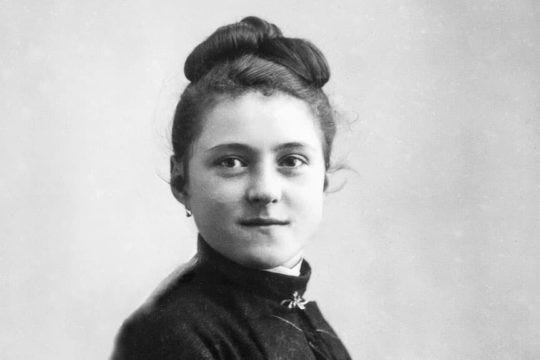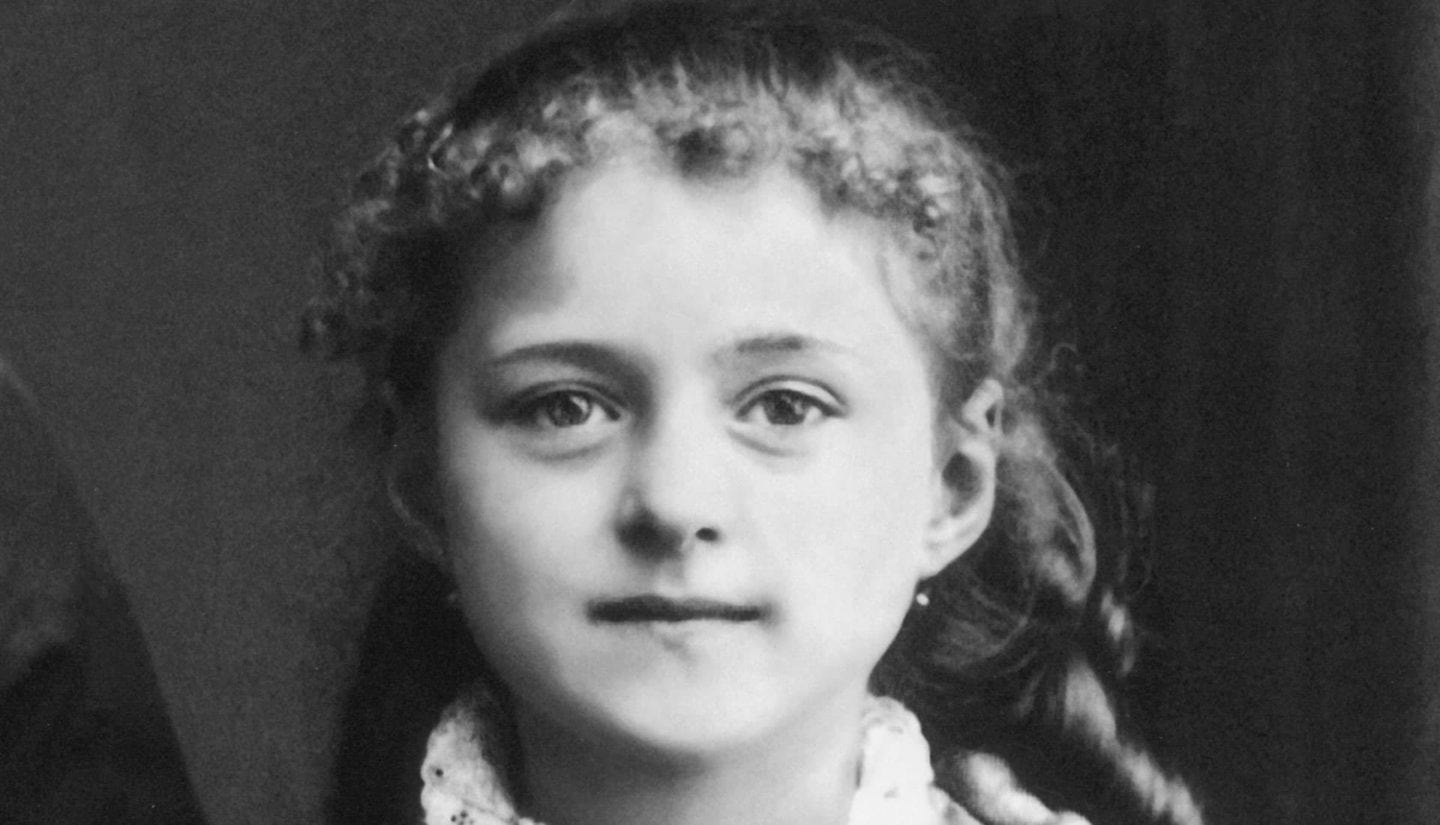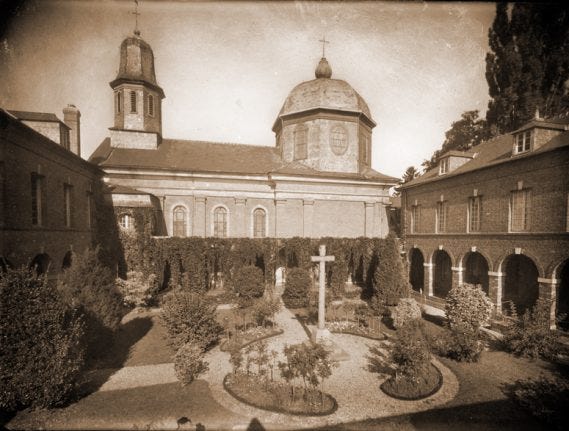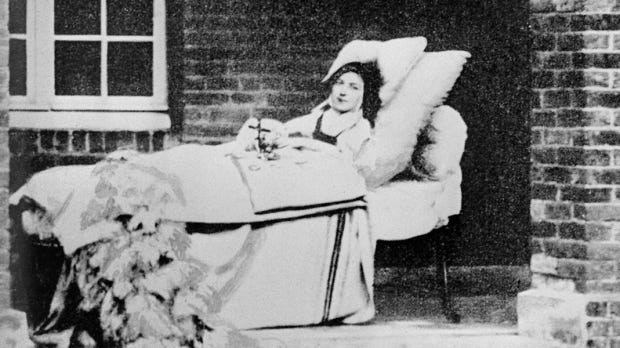My vocation is love.
Advent Day 13: Therese of Lisieux (1873-1897)
For Therese of Lisieux, the path toward sainthood began with a temper tantrum.
The year was 1887 and Therese Martin was on pilgrimage in Italy with her father. The Martins were an unusually devout family (fun fact: they’re all canonized saints!), but Therese was the most devout of all. By the time the Martins had set out for Italy, this spiritually precocious girl had already tried, multiple times, strong-arming her way into the Carmelite convent in her hometown of Lisieux, France, only to be rejected by the convent superiors due to her tender years. Now, Therese was done with the good sisters at the convent. She was going to the top brass.
On November 20, 1887 Pope Leo XIII held a public audience. For hours, people queued up for the chance to get a few seconds with the pope who would make a hasty sign of the cross before an attendant hustled the line forward. Popes had been doing this for ages, and it worked great. But Therese threw a wrench into that well-oiled machine.
Face-to-face with Leo, Therese quickly made her case for entering the convent. She then demanded the pope intervene on her behalf and make the sisters admit her. Leo muttered some words about obeying her superiors then looked past her to the next person in line. But Therese was not done. Unsatisfied with the pope’s dismissal, she dropped to the ground, grabbed Leo’s ankles, and refused to budge.
Remember how Jacob wrestles with God and refuses to let go until he’s received a blessing (Genesis 32:22-32)? It was like that. Only the pope had something God in that story did not: a security detail called the Noble Guard. Therese was promptly carted out of the Vatican and deposited in Saint Peter’s Square.
Now, everyone knows you’re not supposed to reward a tantrum. But Therese had finally exhausted her resistors. When the story of her papal meltdown made its way back to Lisieux, the local bishop relented, granting her a special dispensation. On April 9, 1888, at age fifteen, she entered the convent.
Therese had far more serious ambitions than being a garden-variety nun. Sainthood is what she was after. Nowadays, if asked how one goes about becoming a saint, most would probably say that you must perform great works that touch the lives of millions, and with perfect piety. Never mind that no person—saint or not—can live up to that ideal, Therese also held to this notion. But a funny thing happened to Therese on her way to sainthood: reality.
After a few years of convent living, Therese began to realize that, despite her countless hours of prayer and penance, perfection eluded her. She still got annoyed with the cranky nuns with whom she was cloistered. She was clumsy at making the handicrafts the convent produced. One of the sisters, the finest embroiderer, often bullied her, calling her a big nanny goat.
Of convent life, Therese wrote,
…the lack of judgment, education, the touchiness of some characters, all these things do not make life very pleasant. I know very well that these moral weaknesses are chronic, that there is no hope of a cure.
If the way to heaven was checking off all the boxes on a personal perfection plan, Therese was never going to get there. What she needed was to rebuild the foundation of her spirituality.
One Sunday, closing my book at the end of Mass, a picture of Our Lord on the cross half slipped out, showing only one of his divine hands, pierced and bleeding. My heart was torn with grief to see that precious blood falling to the ground, and no one caring to treasure it. (As it fell) I resolved to remain continually in spirit at the foot of the cross, that I might receive the divine dew of salvation and pour it forth upon souls.
Rather than a faith based in pursuit of self-centered perfection, Therese would become other-centered.
I concluded that God would not inspire desires which could not be realized, and that I may aspire to sanctity in spite of my littleness. For me to become great is impossible. I must bear with myself and my many imperfections; but I will seek out a means of getting to Heaven by a little way—very short and very straight, a little way that is wholly new.
Studying the gospels for the first time in her life (Catholics in Therese’s day rarely read the gospels, and the Old Testament was not even available in the Bible at her convent), Therese awoke to Jesus’s path of loving descent. She found a gateway into the gospels she’d never had before in a culture dominated by a fearsome, angry God: love.
My nature is such that fear makes me recoil…with LOVE not only do I go forward, I fly…Jesus does not demand great actions from us, but simply surrender and gratitude.
For Therese, surrender and gratitude were the gateways to love—for God, her Carmelite sisters, and the whole world.
Love proves itself by deeds, so how am I to show my love? …By scattering “flowers” and these flowers are every little sacrifice, every glance and word, and the doing of the least actions for love.
For Therese the flowers she scattered were smiles for a cranky nun, forgiveness for someone who was cruel to her, prayers for criminals and ex-communicated priests. She peeled potatoes and picked apples with new purpose. Holiness was found sweeping a floor and washing dishes. In her prayers, she contemplated the suffering of Christ and, through that particularity, held in her soul the universal suffering of all people. She called this eminently practical faith the Little Way.
Unfortunately, Therese’s time to walk the Little Way was short. On Good Friday, 1896, after a day of fasting, she felt a hot bubbling in her mouth. Spitting into a napkin, she saw blood and knew instantly she had tuberculosis.
Therese declined rapidly. Recognizing they had a spiritual genius in their midst, her sister Pauline instructed her to begin writing her biography so that future generations might benefit from learning about her Little Way. Therese wrote, often through great suffering, almost up to her last day. She died on September 30, 1897, at the age of twenty-four. Her last words were, My God, I love you.
The life of Therese of Lisieux was short and anonymous. At the time of her death, she had only ever left her home province of Normandy once, during that fateful trip to Rome. She’d spent nearly half her life cloistered and knew next to no one. But as her autobiography, Story of a Soul, began circulating, her teachings attracted a large following. With the dawn of a new century, her Little Way of making a difference in the world through simple, everyday living brought comfort and purpose to people facing the twin cataclysms of the Spanish flu pandemic and a World War.
In the example of her short life, millions found inspiration, including Dorothy Day who chose Therese as her patron saint. Therese’s influence so revolutionized Catholic thought that, in 1921, Pope Benedict XV dispensed with the usual 50-year waiting period for a person to be considered for sainthood. Only three decades after her epic meltdown at the feet of Pope Leo XIII, a half-million pilgrims gathered in Saint Peter’s Square to see Therese of Lisieux canonized. In 1997 she was named the youngest, and fourth female Doctor of the Catholic church.
Practice
Therese of Lisieux invited God into all her daily actions and interactions, no matter how mundane, frustrating, boring or irritating. Through this method, she turned daily living into a sacrament. She called this the Little Way.
Today, consciously invite God into your life. Pick an action or interaction you usually struggle with—your commute, washing the dishes, a conversation with someone you find challenging. See if you can let God’s love infuse this area of your life. Notice how doing so has an impact on you.
Holiday Happenings at Life In The City
Dec. 11, 11:15 am: LITC’s original musical, Make Room In Your Heart.
Dec. 21, 7:30 pm: Blue Christmas, an intimate service for the longest night of the year.
Dec. 23, 7:00 pm: Our annual Christmas Eve-Eve service.
Dec. 25, 11:15 am: Celebrate Christmas morning with your church family.
Jan 1, 11:15 am: A quiet, contemplative service to welcome 2023.
Feedback
This is a first draft of a book that will go to publishers in 2023. If you spot typos or have suggestions, leave them in the comments below or email Greg Durham at greg@lifeinthecityaustin.org.
Catch Up On Recent Posts
Read the Introduction to The Heart Moves Toward Light: Advent With The Mystics, Saints and Prophets.
Recent posts can be found in our Archive.






